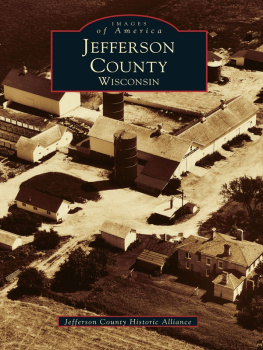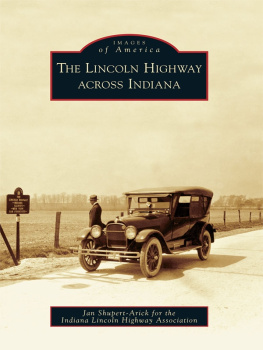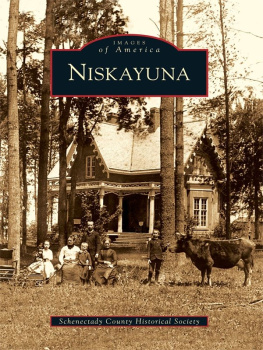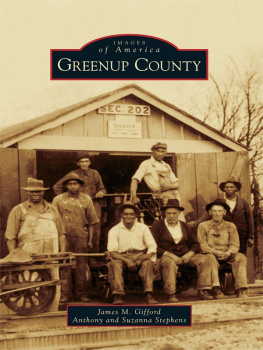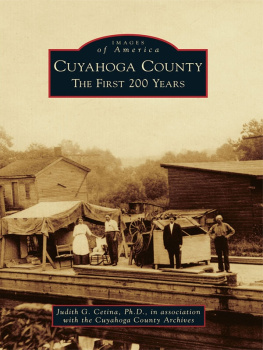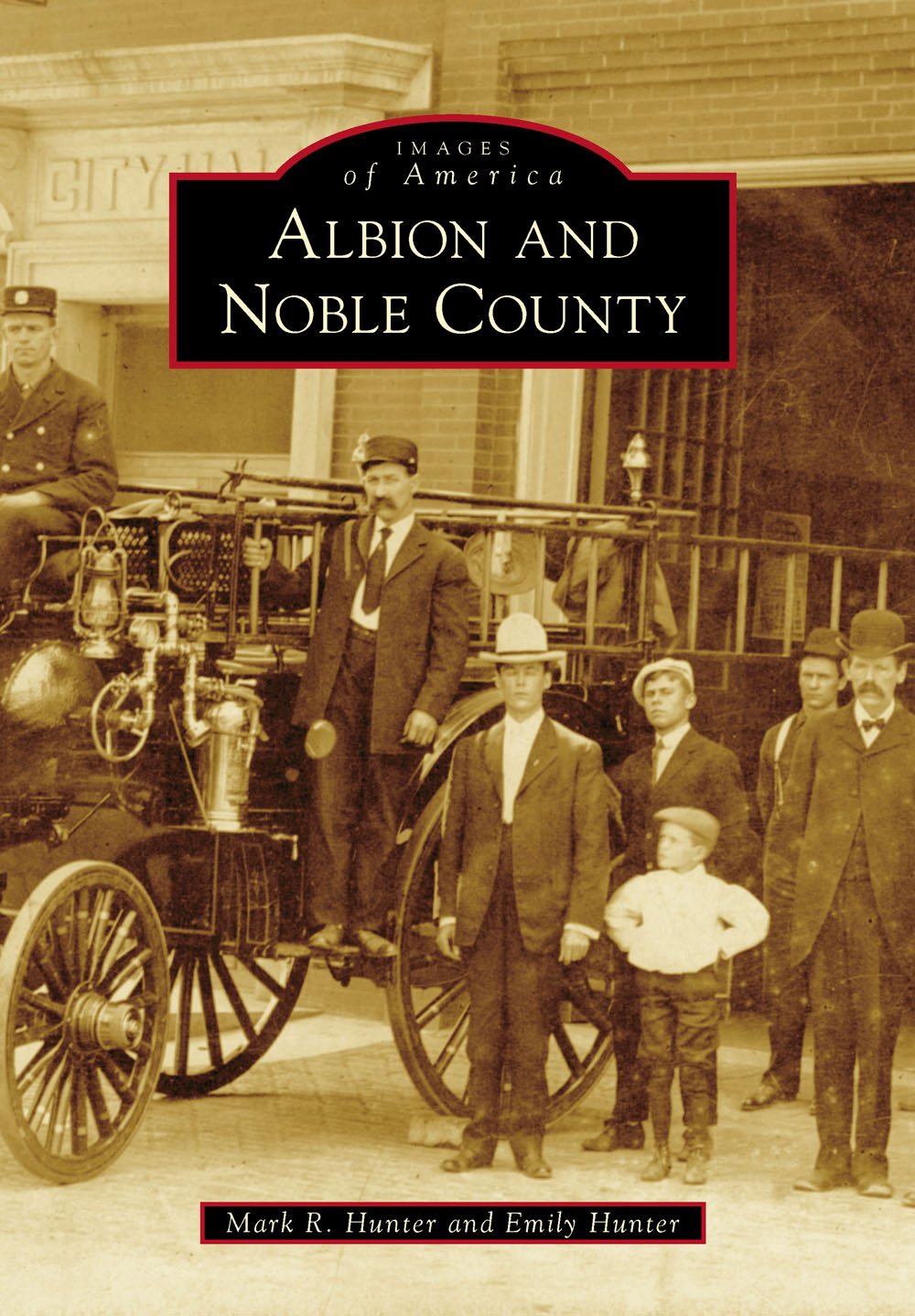
IMAGES
of America
ALBION AND
NOBLE COUNTY

This 1876 map of Noble County shows the growth of early communities, roads, and railways, as well as the swamps and lakes that made travel so difficult. By then, Albion, in the center of the map, had earned the title of county seat. (Courtesy Noble County Historical Society.)
ON THE COVER: Kendallville firefighters pose with their horse-drawn apparatus around 1910. Kendallville, the only city in Noble County at the time, was protected by a pair of full-time firefighters, 17 volunteer firefighters, and two horses. Several other communities in Noble County boasted all-volunteer departments. (Courtesy Mike Mapes.)
IMAGES
of America
ALBION AND
NOBLE COUNTY
Mark R. Hunter and Emily Hunter

Copyright 2015 by Mark R. Hunter and Emily Hunter
ISBN 978-1-4671-1451-6
Ebook ISBN 9781439652923
Published by Arcadia Publishing
Charleston, South Carolina
Library of Congress Control Number: 2015933423
For all general information, please contact Arcadia Publishing:
Telephone 843-853-2070
Fax 843-853-0044
E-mail
For customer service and orders:
Toll-Free 1-888-313-2665
Visit us on the Internet at www.arcadiapublishing.com
To the citizens of Albion and Noble County, especially those who share and preserve the local history of their homes and areas
CONTENTS
ACKNOWLEDGMENTS
A book such as this would not be possible without the assistance of people who care about, research, and preserve history. Special thanks go to the Noble County Historical Society and Old Jail Museum, the Stones Trace Historical Museum, the Mid-America Windmill Museum, Noble County Genealogical Society, the Noble County Public Library, and the Ligonier Historical Society and Museum.
Many individuals have assisted along the way, and I apologize for anyone whom I might miss. They include, but are not limited to, the following: Noble County historian Sarah Knopp, Mike Mapes, Joy LeCount, Bill Shultz, Janet Sweeney, Tom Ryan, Lori Gagen, former Noble County librarian Linda Shultz, Albion town manager Beth Shellman, Judy Richter, Barry Mooney, Marcia Garrett, Ellen McBride, Helen Swanson, Lori Gagen, Tom Ryan, Carla Fiandt, and Vern Christlieb.
Special thanks also go to Maggie Bullwinkel and William Wallace of Arcadia Publishing, who must be particularly patient individuals.
Where noted, the images in this volume appear courtesy of the Noble County Historical Society (NCHS) and the Stones Trace Historical Society (STHS). The Noble County Historical Society has a collection of historic artifacts, photographs, and documents that are kept at the Old Jail Museum, at 215 West Main Street in Albion. The Gothic Revival building was constructed in 1876 as the Noble County Jail, housing both inmates and the sheriffs family until a new jail was built in 1965. It and the 1888 Noble County Courthouse a block away are considered architectural gems in the center of Noble County.
INTRODUCTION
When Indiana was established in 1816, Noble County was forest and swampland, inhabited by Pottawatomie and Miami tribes. Receding glaciers had gouged out many of the areas lakes (called kettle lakes) and deposited rich soil as well as bogs of muck and peat. Noble County now has 117 lakes that were once connected by swamps that covered more than 10 percent of the land.
As part of an agreement with the local Native Americans, the federal government put up a brick residence/council house for Chief Wawaasaa, between 1816 and 1821. The building was destroyed by what was most likely a tornado. After the local tribes moved west, settlers repurposed the fallen bricks to use in constructing their home chimneys.
In April 1827, Joel Bristol and his family became the first recorded white settlers in Noble County. But they may not have been the first white people to see the area. Another settler later found a stone with an engraving that was carved by Andrew Clinton: I was taken prisoner bey the Indians in 1776.
The area was part of Allen County, having previously been in regions attached to first Randolph County, then Knox County. On March 1, 1836, just eight years after the Bristols set up a way station along the Fort WayneGoshen Road, Noble County was officially organized. By then, the new population had already reached about 2,000.
Some say Noble County was named after Noah Noble, Indiana governor from 1831 to 1837. However, historical documents indicate that the name came from his brother James, who served as Indianas first US senator from 1816 until he passed away in 1831.
Many settlers followed the Fort WayneGoshen Trail through the western part of the county. That would later become part of the first transcontinental road, the Lincoln Highwaythe first national memorial to Abraham Lincoln. A 1919 Army convoy trip over that road inspired future president Dwight Eisenhower to champion a national interstate highway system.
With most of the population in the west, it made sense to place the county seat along the future Lincoln Highway. One of the three men appointed to settle the county seats permanent fate was, as fate would have it, a commissioner named George Fate.
The location chosen was Sparta, in the west central part of Noble County. One citizen even allowed his home to be used as the first courthouse, but the seat of government did not stay there for long. In 1837, it was relocated to Augusta, about five miles straight east.
Citizens in Augusta, though small in numbers, were quite open to the idea. In fact, just as a Sparta resident offered up his home as a courthouse, an Augusta property owner actually built a courthouse on his own land and presented it to county officials in 1840. The first taxpayer-funded building was a primitive log jail. Over the next few years, Augusta developed, gaining two hotels, stores, mills, factories, and several attorneys. A fire destroyed the courthouse in early 1843. Although the remains of the original jails cells remained as late as 1882, most of the surrounding land became the Augusta Hills Golf Course before being turned over for farmland.
Port Mitchell, less than three miles south of the countys center, fought for and got the designation of county seat in 1844. Thanks to a dam, the town had the advantage of waterpower and soon boomed with woolen mills, sawmills, and flouring mills. Government buildings were constructed, and Port Mitchell was to be the final moveuntil the state legislature decided two years later to give the people of Noble County a final vote.
A spirited debate resulted over where to place the Noble County seat, with speeches and even a campaign song composed as towns vied for the honor. The first election led to a runoff in 1846, and the final vote resulted in none of the existing towns winning. Instead, the county seat would gothis time permanently, for realto the Center.
The loss of the county seat, along with the collapse of a dam used to power mills, marked the end of Port Mitchells business interests.
The new county seat took its name from the hometown of one of the commissioners appointed to name it: Albion, New York. Town records were moved there in September 1847, and in 1849 a jail was built. In 1859, arson consumed the courthouse and almost took the town with it. In 1876, the jail was replaced with a building that now houses the Noble County Old Jail Museum.
Next page

